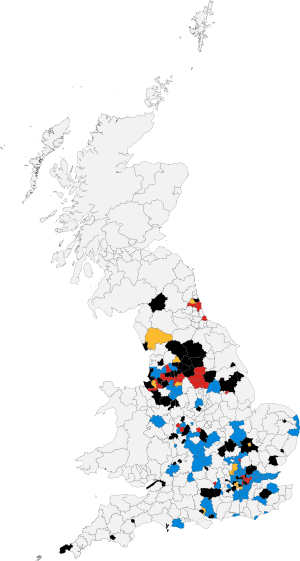| |||||||||||||||||||||||||||||||||||||||||||||
All 32 London boroughs, all 36 metropolitan boroughs, 20 out of 46 unitary authorities and 88 out of 238 English districts | |||||||||||||||||||||||||||||||||||||||||||||
|---|---|---|---|---|---|---|---|---|---|---|---|---|---|---|---|---|---|---|---|---|---|---|---|---|---|---|---|---|---|---|---|---|---|---|---|---|---|---|---|---|---|---|---|---|---|
| |||||||||||||||||||||||||||||||||||||||||||||
 Colours denote council control following elections, as shown in the main table of results. | |||||||||||||||||||||||||||||||||||||||||||||
The 2006 United Kingdom local elections were held on Thursday 4 May 2006.
All London borough council seats were up for election, as well as a third of the seats on each of the metropolitan borough councils, and a third of some unitary authorities and shire districts. Several councils elected half of their seats: these were Adur, Cheltenham, Fareham, Gosport, Hastings, Nuneaton and Bedworth, and Oxford. Local elections follow a four-year cycle, and the 2006 election was the follow-on from the 2002 elections.
Mayoral contests were held in the London boroughs of Hackney, Lewisham and Newham, and in Watford. Crewe and Nantwich held a referendum on the issue of whether or not to have a directly elected mayor.
This was the first set of elections since David Cameron was elected leader of the Conservative Party. The Conservatives strengthened their position as the largest party in local government, making headway against Labour.


